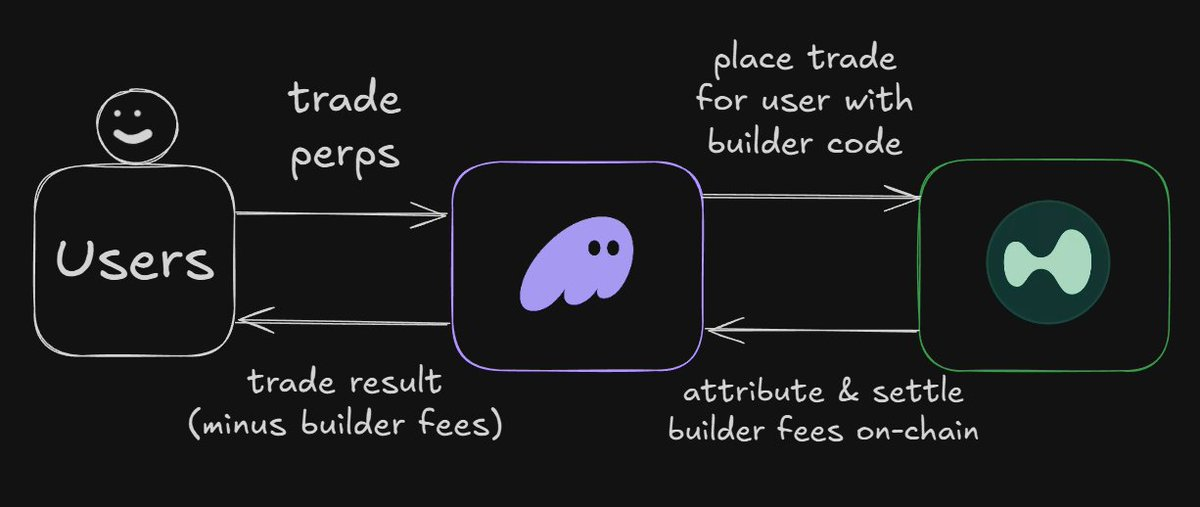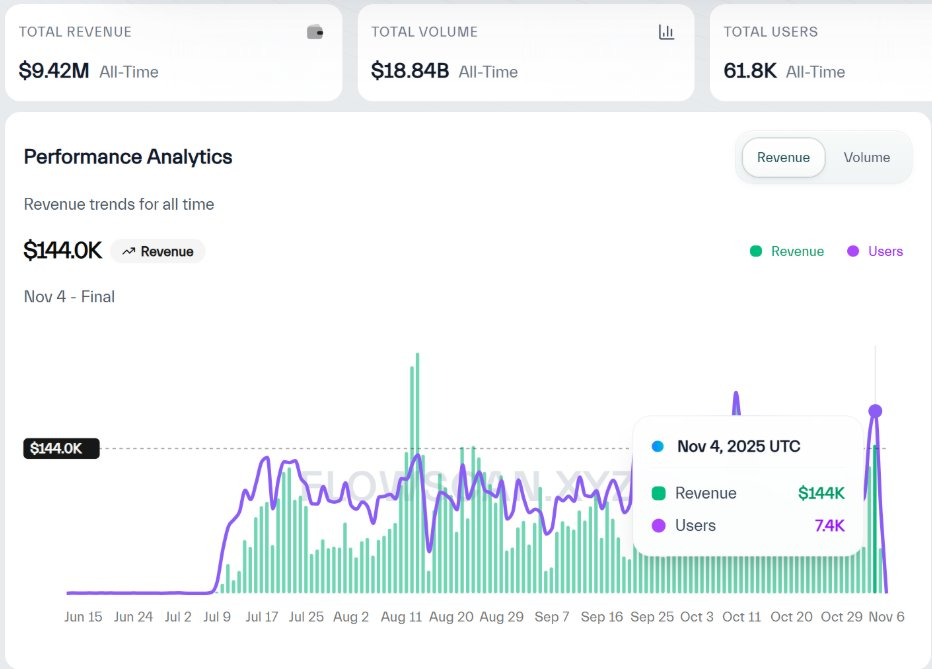The platform serves as a foundation, providing the possibility for thousands of applications to build and profit.
Author: Jarrod Watts
Compiled by: Deep Tide TechFlow
Application developers are quietly building applications on platforms like Hyperliquid and Polymarket, leveraging a new revenue attribution system called "builder codes" to earn millions.
This is a Roblox-like model in the crypto space: the platform serves as a foundation, enabling thousands of applications to build and profit—by attributing unique code activities and distributing revenue.
In this article, I will detail what builder codes are, how applications earn millions through them, and how ERC-8021 proposes to natively integrate this system into Ethereum.
What are builder codes?
Builder codes are essentially referral codes designed for application developers—applications can use them to generate trading volume for another platform (like Hyperliquid) and earn revenue.
This creates an on-chain attribution system that allows third-party applications (such as trading bots, AI agents, and wallet interfaces) to earn fees based on the activity they generate on other platforms.
This system is mutually beneficial for all parties involved:
The platform gains more trading volume;
Application developers earn revenue from the trading volume they generate;
Users enjoy a more convenient way to interact with the platform.
Let’s better understand this through an example—Phantom.
Phantom's perpetual contract revenue "printing machine"
In July of this year, Phantom increased support for perpetual contract trading by using Hyperliquid's builder codes, a decision that currently brings them about $100,000 in revenue daily.
The way it works is by allowing users to transfer funds into a separate perpetual contract account and directly engage in long and short trades within the mobile app.
For each order, Phantom attaches their builder code, charging users a 0.05% fee—these fees are recorded through the on-chain attribution system and can be claimed in USDC.

Image: Phantom "tags" user orders from the Phantom wallet app with builder codes to earn these fees.
Notably, all of this relies on the external API provided by Hyperliquid, making the building process extremely easy and far less costly than developing similar complex features independently.
Phantom's perpetual contract business has shown an astonishing return on investment (ROI)—since its launch in July, Phantom's perpetual contract trading volume has approached $20 billion, earning nearly $10 million in less than six months.

Image: Just yesterday, Phantom earned nearly $150,000 from its perpetual contract business.
Interestingly, Phantom's top perpetual contract user has performed extremely poorly:
Lost 99% of their approximately $2 million perpetual contract portfolio;
A net loss of $1.8 million;
Paid about $191,000 in fees to Phantom through builder codes. Currently, the user's only position is a 25x leveraged ETH long (how to interpret this information depends on you).
Unless everyone loses their funds like this user, Hyperliquid will continue to generate substantial revenue for developers like Phantom who bring trading volume to its platform.
So far, Hyperliquid's builder codes have achieved:
Earned nearly $40 million in revenue for application developers;
Provided a diversified and improved user interface for perpetual contract trading;
Created over $100 billion in additional perpetual contract trading volume for Hyperliquid!
The success of this model has been quickly validated, attracting many excellent application developers to build high-quality applications on Hyperliquid.
Polymarket follows closely
This week, Polymarket announced a similar builder program designed to reward application developers for bringing trading volume to its prediction markets.
To promote the integration of builder codes, Polymarket launched a weekly USDC reward program based on integrated trading volume.
Although the trading volume from third-party Polymarket applications is currently far lower than Hyperliquid, its builder codes have already attracted some teams to develop user interfaces, providing users with unique prediction methods.

Image: Over $50 million in betting volume has been completed through third-party Polymarket applications.
Polymarket seems to be helping to expand the range of builder applications, from trading terminals to AI assistants, and has also created a dashboard similar to Hyperliquid to showcase top builders and their rewards.
Other prediction markets are expected to launch similar programs to compete, and a broader application ecosystem may follow this successful referral system model.
However, Ethereum has the opportunity to elevate this model to new heights, encouraging high-quality application developers to create innovative user interfaces based on the mature and reliable Ethereum platform.
ERC-8021 and the opportunities for Ethereum
Ethereum now has the chance to natively integrate builder codes into both L2 and L1 layers, and a recent proposal has suggested an interesting implementation method.
ERC-8021 proposes to embed builder codes directly into transactions, while combining it with a registry where developers can provide wallet addresses to receive revenue.
Implementing this proposal would provide a standardized way to add builder codes to any transaction while defining a universal mechanism for platforms to reward application developers for the trading volume they generate.
ERC-8021 includes two core components:
New transaction suffix: Developers can add small data at the end of transactions to include their builder codes, such as "phantom," "my-app," or "jarrod."
Code registry: A smart contract where developers can map their builder codes to wallet addresses to receive platform revenue distributions.

Builder codes can be added to the end of transaction data and optionally mapped to a wallet address to receive revenue.
This would allow any platform to attribute on-chain activity to the applications from which it originated and directly distribute revenue to these developers in a transparent and programmable manner.
Conclusion
Hyperliquid users may already be familiar with builder codes, but upon deeper investigation, the extent of their rapid adoption in a short time is indeed astonishing.
The reasons for their success are evident: builders are rewarded for creating high-quality consumer applications based on powerful primitives in the crypto space.
Ethereum has a large existing pool of high-quality platforms that can be integrated into a standardized builder code system to drive a new wave of consumer-facing applications.
Builder codes unlock new revenue streams for high-quality application developers, which do not rely on funding from conference parties but are based on the value they provide to users.
免责声明:本文章仅代表作者个人观点,不代表本平台的立场和观点。本文章仅供信息分享,不构成对任何人的任何投资建议。用户与作者之间的任何争议,与本平台无关。如网页中刊载的文章或图片涉及侵权,请提供相关的权利证明和身份证明发送邮件到support@aicoin.com,本平台相关工作人员将会进行核查。




